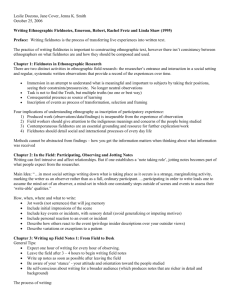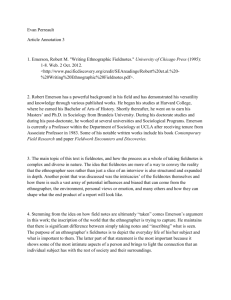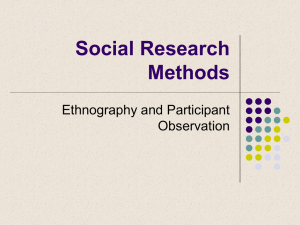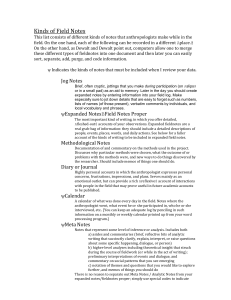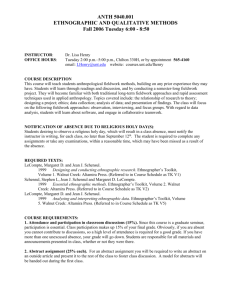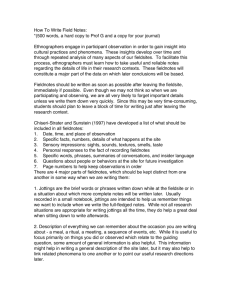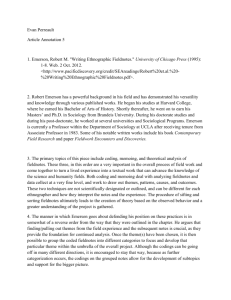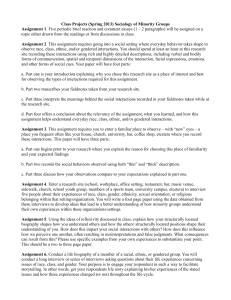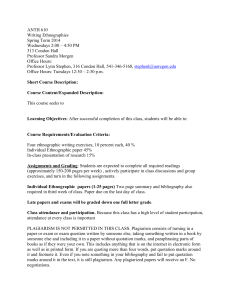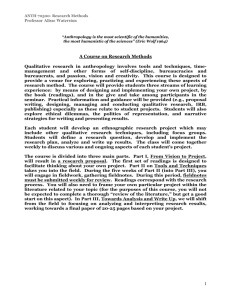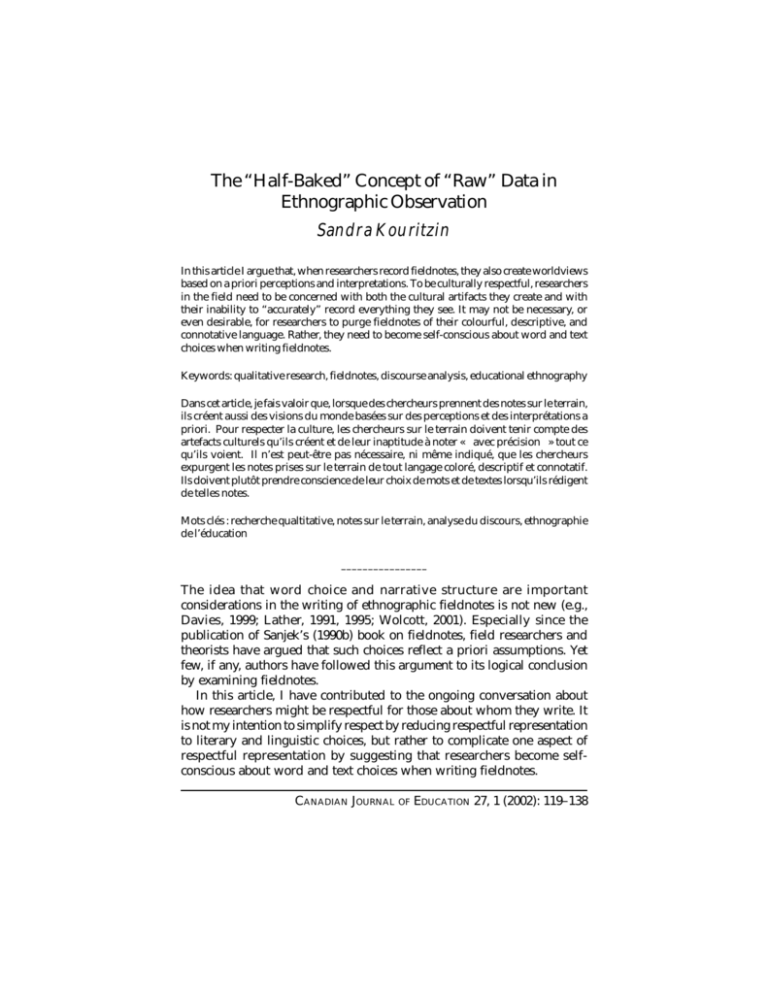
The “Half-Baked” Concept of “Raw” Data in
Ethnographic Observation
Sand ra Kouritzin
In this article I argue that, when researchers record fieldnotes, they also create worldviews
based on a priori perceptions and interpretations. To be culturally respectful, researchers
in the field need to be concerned with both the cultural artifacts they create and with
their inability to “accurately” record everything they see. It may not be necessary, or
even desirable, for researchers to purge fieldnotes of their colourful, descriptive, and
connotative language. Rather, they need to become self-conscious about word and text
choices when writing fieldnotes.
Keywords: qualitative research, fieldnotes, discourse analysis, educational ethnography
Dans cet article, je fais valoir que, lorsque des chercheurs prennent des notes sur le terrain,
ils créent aussi des visions du monde basées sur des perceptions et des interprétations a
priori. Pour respecter la culture, les chercheurs sur le terrain doivent tenir compte des
artefacts culturels qu’ils créent et de leur inaptitude à noter « avec précision » tout ce
qu’ils voient. Il n’est peut-être pas nécessaire, ni même indiqué, que les chercheurs
expurgent les notes prises sur le terrain de tout langage coloré, descriptif et connotatif.
Ils doivent plutôt prendre conscience de leur choix de mots et de textes lorsqu’ils rédigent
de telles notes.
Mots clés : recherche qualtitative, notes sur le terrain, analyse du discours, ethnographie
de l’éducation
––––––––––––––––
The idea that word choice and narrative structure are important
considerations in the writing of ethnographic fieldnotes is not new (e.g.,
Davies, 1999; Lather, 1991, 1995; Wolcott, 2001). Especially since the
publication of Sanjek’s (1990b) book on fieldnotes, field researchers and
theorists have argued that such choices reflect a priori assumptions. Yet
few, if any, authors have followed this argument to its logical conclusion
by examining fieldnotes.
In this article, I have contributed to the ongoing conversation about
how researchers might be respectful for those about whom they write. It
is not my intention to simplify respect by reducing respectful representation
to literary and linguistic choices, but rather to complicate one aspect of
respectful representation by suggesting that researchers become selfconscious about word and text choices when writing fieldnotes.
CANADIAN JOURNAL OF EDUCATION 27, 1 (2002): 119–138
120
SANDRA KOURITZIN
A REVIEW OF FIELDNOTE TEXT-CREATION ADVICE
Sanjek (1990b) reported an address by James Clifford during the 1984
American Anthropological Association meeting. Sanjek noted Clifford’s
comment: “in all the recent discussion about writing ethnography and
about ethnographies as writing, no one [has] addressed what
anthropologists write before they write ethnographies — fieldnotes” (p.
xi). This comment eventually led to a panel on that topic at the 1985 annual
meeting, and the subsequent publication of Sanjek’s (1990b) aptly titled
book Fieldnotes: The Makings of Anthropology.
Perhaps reflective of the absence of earlier fieldnote discussions, many
contributors to Sanjek’s volume seemed more concerned with how
researchers use fieldnotes, in what anthropological state(s) they create them,
and what items qualify as fieldnotes, than with the textual properties of
fieldnotes (e.g., Clifford, 1990; Jackson, 1990; Johnson & Johnson, 1990;
Obbo, 1990; Sanjek, 1990c, 1990a; see also Geertz, 1973; Rose, 1990; Van
Maanen, 1988; Wolf 1992). Most distinctions in fieldnote definition are
essentially researcher-bound: fieldnotes are field memories, written down1
or otherwise recorded, produced or commissioned by the ethnographer,
arranged chronologically rather than thematically, representing the cultural
maturation of the anthropologist in a given setting (Ottenberg, 1990; Plath,
1990), and therefore heavily imbued with personal meaning.
Although recent scholars have written several volumes (e.g., Amit, 2000;
Emerson, Fretz, & Shaw, 1995), and articles (e.g., Davies, 1999; Emerson,
Fretz, & Shaw, 2001; Lapadat & Lindsay, 1999; Rapport, 2000; Spencer,
2001) dedicated to understanding how personal meaning is made manifest
in fieldnotes, researchers have made little or no mention of how to describe
events, people or objects; how to use language(s) in description; how to
use or avoid rhetorical strategies; or how to use or avoid linguistic
strategies, and why. Exceptions are normally such easily missed and unelaborated bits of advice as “we should always try to note concrete instances
of what people have said or done, using verbatim quotations and ‘flat’ (or
unadorned) descriptions” (Silverman, 2001, pp. 68). Little recognition of
the importance of language in fieldnotes occurs, and no warning that
linguistic choices will ultimately be of paramount importance (e.g.,
Delamont, 2002; Kirby & McKenna, 1989).
In a manner similar to verbatim transcriptions, fieldnotes are
interpretations or representations that follow from the purposes and
working theories of the researchers, as well as from general assumptions
about the transparency of language (Lapadat & Lindsay, 1999). After
several years, memory fades and only fieldnote records remain of actions,
THE “HALF-BAKED” CONCEPT OF “RAW” DATA IN ETHNOGRAPHIC OBSERVATION
121
events, and conversations. Yet texts are, for the most part, mute on the
subject of fieldnote language, and do not demonstrate how, exactly,
fieldnotes go about endowing behaviour with significance.
One exception is Spradley’s (1980) caution that
the moment you begin writing down what you see and hear, you automatically encode
things in language. This may seem a rather straightforward matter, but the language
used in fieldnotes has numerous long-range consequences for your research. (p. 64–65)
Spradley, however, was talking about language (parole and dialect) rather
than about language choice.2 To facilitate description, he argued that field
workers can generate lists of concrete verbs and nouns that might be
appropriate in the field situation. He suggested that, if researchers intended
to observe people standing in a line-up, they might list in advance such
words as shifting, searching, wagging, nodding, glaring, or beelining, alone
or in combination with other words, to aid concrete description. Spradley
implies that these words are value-neutral.
In contrast, I contend that these words are completely value-laden. When
using such words, researchers reflect personal and subjective judgments
about the state of mind of the people they describe. In this sense, such lists
of words can lead to less rather than more concrete description; they lead
rather to “thick description” (Ryle, 1971, p. 482), a more interpretive than
descriptive act (Geertz, 1973, pp. 5–30).
Hammersley and Atkinson (1995) advocated the use of concrete
description and verbatim transcription to minimize inference. According
to Hammersley and Atkinson, fieldnotes become interpretive as a result
of what researchers omit or because of the partiality of an account, rather
than as a result of the language used to describe a place, event, or situation.
Hammersley and Atkinson appeared to be more concerned with how
phenomena are distorted by fieldnotes than about how interpretations of
phenomena are created in fieldnotes. It is, perhaps, more productive to
accept that researchers “are still subjective people doing a subjective job”
(Ely et al. 1991, p. 54).
FIELDNOTE EXTRACTS
In the following discussion, I have looked at several examples from
fieldnotes taken from three sources: my own observations in public areas,
and Wolf’s (1992) and Spradley’s (1980) published sources. In this
discussion, I have explained how simply choosing words and forms when
writing fieldnotes constitutes the active creation of cultural artifacts.
122
SANDRA KOURITZIN
The first extract is an observation assignment that I completed as a
student in an educational research class. We were instructed to write
everything we saw, felt, and thought.3
SALVATION ARMY RESIDENCE FOR MEN, LOBBY, NOVEMBER 27, 1992 (THE
FRIDAY NIGHT BEFORE WELFARE CHEQUES), 9:37 P.M.
As I enter the lobby, a very tanned-looking, but yet not tanned really, but weathered, man
with bulging eyes like a baby bird looks at me. He is wearing a navy blue jacket and
pants. I don’t want to seem to be looking at him. I walk past him and sit on the heater at
the back of the room where he is just out of view. So m e thing about him makes me feel
very uncomfortable - a feeling I don’t get from anyone else in the room. I have visions of
him peeing on the street, and aggressively shouting on street corners about the coming of
Jesus. There’s a no-smoking sign on the wall to my left. Suddenly a bell rings. Instinctively
I know that it belongs to the locked door that goes into the residence, and I look up in
time to see a new blond entrant wearing jeans and a light blue jacket approach the front
desk. He receives a key attached to a small brown plywood board and walks to the back
of the room to a small room I assume is the bathroom. In the background, from behind
the front desk I can hear the sound of money in a dispenser, perhaps a vending machine,
but it’s clicking without stopping, regularly. The front desk is like a glassed-in cage, but
its walls do not go all the way to the ceiling. I realize that I can hear because of this. The
new entrant leaves the bathroom quickly and is buzzed into the residence hall. There is a
small portable T.V. sitting on top of a large old cabinet T.V. playing in the front corner of
the room with something violent on the screen. There’s lots of excitement on the T.V., but
the people in the room, except for one man, are not watching it. There is a man sitting on
the third chair from the passage into this room. This man catches my eye. He has a long
nose and is wearing an English tam, a dark blue blazer, blue shirt, blue sweater, grey
slacks, and high-top runners, which look incongruous. For some reason, visions of veterans
in the November 11th Memorial Services come to m e . He has perfectly correct posture,
and he looks around alertly while everyone else is sleeping. The man at the registration
window looks vacantly out into the room and rubs the baby finger and ring finger on his
right hand with his right thumb. If I listen carefully, I think I can hear a dry rasping sound
from this motion….A short man leading with his nose in a way that reminds me of a
hunting dog, and strutting with that peculiar turkey walk, in which the head pushes
forward at every step, ploughs through. He is wearing a black trench coat. I think
“Mafioso”. He is followed by a tall unsteady Native man, who seems to be a drunk in
need of a drink. The odd couple. Wendy suddenly appears and says “do you wanna go?”
I do. I stand up to zip my jacket, and catch the eye of the man in the overcoat and beard
seated on the heater. He is wearing a knitted cap. His eyes are sunken and hunted-looking.
. . . [class assignment, 1992]
I composed the next extract for another class assignment over a year
later. I was instructed to conduct a patronizing and orientalist observation
in a public place and then to reflect on the process. My analysis of this
observation sequence radically altered my orientation to participantobservation and my own role in it. Being patronizing was disturbingly
easy for me.4 There are many instances in this passage in which I have
THE “HALF-BAKED” CONCEPT OF “RAW” DATA IN ETHNOGRAPHIC OBSERVATION
123
consciously employed patronizing language and deliberately abused
insider knowledge, but I have focused instead on those descriptive passages
that unconsciously created culture.
CHINATOWN, NOVEMBER 26, 1993, 2:30 P.M.
I decided to perch on a rock in the sunshine opposite a fish and vegetable market.
From my rock I had an excellent view of the bins containing live lobster, live crab, live
eels, and live prawns. These were located next to bins of fresh tomatoes, spinach, Chinese
cabbage, peppers, and other containers filled with different varieties of dried shrimps,
mushrooms, and other oddly aromatic edibles. I also had an extraordinarily good angle
on the people scooping this live bait into plastic bags but neglecting to pour in any water
so that I could think only of the prawns slowly choking, gasping, thrashing their little
prawn legs, and dying.
Directly in my line of vision was a middle-aged man with the average Chinese middleaged male haircut (parted on the side, straight, cut rounded into the head as if someone
had put a Chinese soup bowl over his head and cut around it). He was dressed in a white
laboratory coat and white pants with a large rubber yellow body apron, elbow length
yellow rubber gloves with gladiator cuffs, and, the piece de resistance, huge yellow rubber
galoshes. . . . [His] job is running cold water and spooning ice over live seafood, handling
slimy sea creatures, gutting fish, and scooping their entrails into a garbage basin, and
running around shouting in a great and glorious panic. The bright colours give the
impression that the food, standing in open containers on the street next to a Smithrite
disposal unit, where people can easily breathe on, paw, and soil what others will put in
their mouths, is clean.
As I settle onto my rock, I hear a sudden outburst behind me. I turn to look and see a
man in a blue (not navy, not indigo, but crayon blue) business suit walking across the
lawn in front of a high-rise apartment building. His companion is a shorter, older man in
a brown business suit whose appearance strikes me as resembling an aged land turtle
craning its neck out of its shell. Trying to look very official they succeed only in looking
pompous and bombastic. The man in blue begins yelling at an old woman dressed in a
black windbreaker, navy blue stretch pants, and a flowered shirt who helps her grandson
out of a Japanese-make car parked in a “permit parking only” space, and then walks
down the sidewalk toward the markets with her grandson in tow. . . . The man in blue
appears to be very angry and continues harassing the old woman who seems to make
smart remarks back to him. The man in the brown suit stands beneath the apartment
building and looks up at it. He has disassociated himself from the scene. The man in blue
spreads his arms in an angry gesture and the old woman begins laughing uproariously at
the spectacle of him standing there, arms akimbo. . . .
[Back] at the fish market, several women are crowding and pushing near the live
seafood. They are all clutching plastic bags and are using tongs to pick up, inspect, and
choose each piece. Two old men are standing detached from the group with their hands
behind their backs, watching. One of them is rolling back and forth on his feet. One
younger man with a child on his shoulders is hovering near a young woman while she is
picking out prawns. Another couple comes into view and stops. They look into the bins.
They exchange a few words. They continue to walk along the sidewalk. A large family
crosses the street in front of me. When they near the fish market, the grandfather, father
124
SANDRA KOURITZIN
and young children stand back while the mother and a daughter who appears to be
about twelve go to look at the fish. The mother motions to the daughter. She fetches a
plastic bag. They begin to pick through the crabs. The mother uses the tongs to fish them
out while the daughter holds the bag. The father stands silently with his hands behind his
back. [class assignment, 1994]
I have taken the third extract from Wolf’s (1992) fieldnotes published in
A Thrice To ld Tale : Fe m inism , Po s t m o d e r n i s m a n d E t h n o g r a p h i c
Responsibility. I chose this extract because it was significant in her book.
Wolf cited the events in this extract three times in her book: as fieldnotes,
as story, and as evidence in an academic journal article.5
WOLF IN CHINA [approximately 19606]
After a little, 128 again tried to leave, and 48 suddenly jumped up and pointed at 85 (F
32) and told her to approach. 85 had been chatting with some other women about some
medicine that she had put on her eyes which appeared to be infected. . . .
Wu Chieh was speechless with fear. 48’s mother told her to answer, and Wu Chieh
managed to blurt out, “Yes.” 48 hugged her very close and put her face against Wu
Chieh’s. Her mother said: “She wants to kiss you.” 48 said, “No! No! No!” and her mother
said quickly, “No, I am wrong. I am wrong. I am just an old lady who doesn’t understand.”
. . . 48 began to make wide sweeping bai-bai gestures, and said, “People should not be
judgmental, saying this person is good and that person is bad.” Then she began to “jump”
again, and 94 (M 31) hissed at Wu Chieh, “Stupid child, aren’t you going to run away?”
Some little boys were giggling. . . . 48 turned on the boys and shouted, “Go away if you
don’t believe. Go away.” She waved them off as if they were curious chickens, and they
scattered like chickens. . . .
As she talked, she continued to make bai-bai motions, to jump about, and finally fell
over backward on the ground. She lay on the ground for some time, and Wu Chieh said
that when she opened her eyelids, all she could see were the whites of her eyes. . . .
People moved off to the edge of the yard, some of them whispering, some of them
laughing, but after a bit, the crowd slowly began to edge toward the house. . . . [A]fter a
while, 48 got to her feet and staggered after her into the house like she was drunk, feeling
along the wall for the door to the bedroom. She kept right on doing bai-bai gestures,
however. Wu Chieh led her to the bedroom and got her to lie down. She did, but without
pausing in her gestures, counting, calculating, and doing bai-bai Wu Chieh ran out. (pp.
72–75)
In the final fieldnote extract, I have used Spradley’s (1980) observations
of his first day in Marshall County Criminal Court as a grand jury member.
SPRADLEY IN CRIMINAL COURT [approximately 19757]
I parked near the county courthouse and walked the short distance to the new building.
Streams of people flowed into the lobby and scrambled into the waiting doors of elevators.
“Going up sir?” a young man called to me from one of the eight elevators. I nodded,
stepped in, and waited until he stopped at the eighth floor where I knew the Marshall
County Criminal Court was located.
THE “HALF-BAKED” CONCEPT OF “RAW” DATA IN ETHNOGRAPHIC OBSERVATION
125
I followed the hallway until I saw a sign over two large doors: CRIMINAL COURT. I
decided to go in even though there was still five minutes before the appointed hour of
9:00 A.M. I pushed open one of the swinging doors and found myself in a large courtroom.
There were rows of spectator benches, all made of heavy dark wood, oak, or walnut,
to match the paneled walls. The rows of benches went for more than twenty-five feet
until they met a railing that seemed to neatly mark off a large area for “official business.”
I went in, sat down in the last row of spectators’ benches, and looked around at the few
other people seated at various places in the courtroom. The high ceiling and heavy dark
wood made me feel as if I were in a sacred, almost religious place. Two people sitting in
front of me were talking in hushed tones and I could not hear what they said. As
newcomers came in, they would stop, look around, and then move very slowly to find a
place to sit. At the right of the area behind the railing were twelve high-back leather
chairs behind another railing. A large oak table with massive chairs all faced toward a
high lectern which I took to be the judge’s bench. All this area was empty. I waited.
A few minutes after nine a man walked in with a brisk manner. He looked at the people
scattered around the large courtroom, all of us in the spectators’ area, and said, “Hello. I
assume you are all here for the prospective grand jury. Judge Fred Adams is going to be on
the bench and it would be better if you all sat in the jury box.” Slowly people got up and I
joined them as we moved together toward the front. . . . I took out a tablet and began
making fieldnotes. I wondered if the people around me thought I was writing a letter or
what. I was conscious of standing out in my casual clothes and beard. All the others were
dressed neatly; the men in suits and ties, some in sport coats. Many dark business suits.
They all looked professional. The women were well dressed in suits, dresses, high heels,
make-up. All looked older than myself. It was as if they had all dressed for some formal
occasion. I felt a little out of place, but decided that didn’t matter. . . .
The man who was reading our names was joined by a sheriff’s officer in full uniform,
gun mounted on his left hip. He walked across the courtroom and stood near a door near
the high judge’s bench. The man and the police officer kept looking at each other, one
glanced at his watch, there was an air of expectancy in the jury box also. (pp. 74–75)
Even though I conducted my two observations above relatively recently, I
do not remember these images at all. Because Wolf and Spradley conducted
their observations long ago, I would find it difficult to believe that they
could remember the incidents in their fieldnotes with any more clarity
than I do (for confirmation: Sanjek, 1990d, p. 334; Smith, 1990, pp. 367–
369; Van Maanen, 1988, p. 124; Wolf, 1990, p. 346). These fieldnote extracts,
then, are very likely the only records that remain of the activities and actions
on those days, unless other researchers were conducting observations at
the same time.
To the best of my knowledge, no one could refute anything written in
these fieldnote extracts. They are therefore authoritative, in whatever form
they have been written. This authority is created and reinforced not only
by the uniqueness of the documents, but also by the overarching narrative
and rhetorical strategies, and by the linguistic devices employed by each
researcher (word choice, verb form, and syntactic style).
126
SANDRA KOURITZIN
Narrative Structures and Rhetorical Strategies
The overarching structure of my 1994 extract and Spradley’s extract is
that of a journey — a common motif, given the relationship of ethnography
to travel writing (Pratt, 1986). In addition to signaling travel in an
experiential and physical sense (e.g., Rapport, 2000), the journey motif
contains two narrative possibilities. The first possibility, found in my 1994
extract, features me as a sophisticated urbanite, roaming through a society
to which I feel superior; the second possibility, found in Spradley’s extract,
features a less sophisticated, more confused, person, unable to understand
the civilization into which he has been cast. These two narratives are not
just journeys; they illustrate a kind of literary quest-romance, an adventure
in search of the Holy Grail, a search for something sacred but visible only
to those who are morally and spiritually worthy. In both instances, the
researcher journeys through a dark and dangerous place,8 then finds a
place to sit and observe from a fixed position, outside the central action,
seeing everything but remaining unobserved. In both instances, during
the prolonged fieldnote sequence the researcher is forced to move from
this position of comfort to another place by an intrusive male authority.9
Despite differences in time, geography, and social position, Spradley
and I actually wrote similar narratives, conforming to familiar genres,
and using “I” as the protagonist. The effect of the journey narratives is
twofold. First, the familiar genre and first-person narration privilege unity
over disunity and univocality over polyvocality. Second, the genre makes
the observation locales seem remote and somewhat dangerous, “wild,”
and away from the normal patterns of our lives. Said (1979) has described
this practice as “designating in one’s mind a familiar space which is ‘ours’
and an unfamiliar space beyond ‘ours’ which is ‘theirs’ [as] a way of making
geographical distinctions that can b e entirely arbitrary” (p. 54). The
geographical distinctions in these fieldnote extracts, although they are
recognizable boundaries, are arbitrary and artificial.
Rhetorically, all four of these extracts have a finished feel to them, though
the passage written by Wolf is more polyphonic and less polished than the
others. Some of the sentences in each observation are labyrinthine, filled
with dependent clauses, participial phrases, and co-ordination, woven into
complex sentences. The effect of this kind of writing makes fieldnotes feel
like literature, indirect and removed from the scene, and meant to be read
by an audience. If fieldnotes can be read as literature, then literary
conventions hold — that is, the narrator is not the same person as the
writer; the writer is behind, authoritative, in touch with the “truth,” the
objective creator of the narrator who is telling the story.
THE “HALF-BAKED” CONCEPT OF “RAW” DATA IN ETHNOGRAPHIC OBSERVATION
127
The complex sentences likewise imply that there has been time to reflect
on these experiences, to craft sentences, time to enhance the reliability of
the descriptions. Emerson et al. (2001) suggested that ethnographers choose
between writing “from some known ‘end-point’ of more or less complete
knowledge” that includes incorporating subsequent knowledge into the
fieldnotes, and “represent[ing] events unfolding ‘in real time’ from a
perspective of incomplete or partial knowledge” (p. 359). They later
suggested that
fieldnote tales tend to be episodic, a string of action chunks put down on the page, one
after another. Thus, both in structure and content, fieldnote tales generally differ from
constructed, dramatic narratives. The highly crafted narratives of published writers not
only describe actions chronologically, but they also ‘make something happen’ by building
suspense into the unfolding action and by creating motivated characters whose
consequential actions lead to instructive, often dramatic outcomes. But, most of everyday
life does not happen like dramatic stories. (p. 359)
While I would not discount their argument, I do not think it “pushes” far
enough. As a researcher who frequently engages in fieldnote writing, I am
a writer, and I am self-conscious about fieldnote writing, even while doing
it (see Amit, 2000). If I were not comfortable with writing highly descriptive,
ongoing accounts of my world, I would not choose forms of research that
demanded this of me. I would have more empathy for a question asked
by one of my colleagues: “How do you know what to write when you
don’t know what you’re looking at?”
Writers, like all human beings, impose order on the everyday
phenomena they observe. Like many writers of academic text, I write my
way into understanding, working through my ideas on paper. Richardson
(2000) describes my practice well; when I am able to write into knowing,
as opposed to writing about what I know, I become liberated from
traditional forms of science writing, and my “writing is validated as a
method of knowing” (p. 929). Because I cannot observe and record
everything, I choose what to focus on, when an episode begins, when it
ends, and I make literary choices that reflect those decisions. Even while
writing as quickly as I can to record as much as I can, I often block out
something that is happening to finish recording something I just observed.
I do not merely impose interpretation on the text after I have created it;
the choices I make regarding what to write about, and how to write it, are
themselves interpretation. Thinking in complete sentences is interpretation.
Choosing between two short sentences or one long one is interpretation.
Choosing to write a dependent clause is interpretation. Some forms of
interpretation are merely more conscious than others.
128
SANDRA KOURITZIN
A second and related rhetorical structure that is used in these fieldnote
selections is the list, particularly lists of parallel grammatical forms. In my
1992 extract, I list items of clothing and adjectives; in my 1994 extract, I
list food items and action words; in her extract, Wolf listed actions; in his
extract, Spradley listed actions and objects. Lists serve two purposes. The
first is that lists impose a scientific notion of order on perceived disorder;
they create categorizations and classifications. The second function of lists
is that they can give a sense of immediacy to what the researcher is
describing, lending more ethnographic authority to the text. For example,
in the 1994 Chinatown extract I wrote that one man’s job is “running cold
water and spooning ice over live seafood, handling slimy sea creatures,
gutting fish and sco o p ing their entrails into a garbage basin, and running
around shouting,” thereby giving a sense that these activities were going
on simultaneously. I created the perception of disorder and systematized
the activities into a repetitive refrain, giving order but reducing a man’s
work to a list of gerunds.
In the extract, Spradley created a similar effect: “As newcomers came
in, they would stop, look around, and then move very slowly to find a
place to sit.” Spradley has given the readers the sense that each person
coming into the courthouse behaved in a highly regularized manner, a
manner probably created by the unfamiliar situation. It is likely, however,
that the activity was not quite so systematic or repetitive; some newcomers
may have hesitated, others stopped, still others may have simply focused
on a place to sit and walked to it. Spradley imposed a systematic order on
what may well have been disorder; the effect for the reader is an
understanding that the newcomers find themselves in an unfamiliar and
uncomfortable location.
Use of familiar genres like the journey motif, or creating disorder from
order through the use of lists is not, in itself, bad fieldnote practice. The
journey is a chronological organizing framework, in many ways
intellectually honest in that it helps to structure the fieldnotes around how
things happened to the fieldworker. The list, likewise, is not inherently
evil. Lists, in fact, structure description or sequence to show that the
researcher saw items or activities to be of equal importance, and that the
researcher can only record the perspective of the researcher. Neither lists
nor the journey undertaken by the researcher distort experience to a greater
or lesser degree than any other organizing framework. The danger is in
assuming that the order imposed by these frameworks exists “out there”
rather than being an arbitrary system that the researcher, consciously or
unconsciously, has chosen.
THE “HALF-BAKED” CONCEPT OF “RAW” DATA IN ETHNOGRAPHIC OBSERVATION
129
Linguistic Devices
The number and intensity of animal images in all of these extracts is
striking. In the Salvation Army sequence, I describe one man as having
“bulging eyes like a baby bird,” and another as “leading with his nose . . .
[like] a hunting dog,” and “strutting with that peculiar turkey walk.” The
people in my Chinatown observation do not select fish, but “scoop” it,
nor do they touch food, but “paw” it. A man in a business suit is described
as “an aged land turtle craning its neck out of its shell,” while later women
“clutch” plastic bags as if in their talons, or send their daughters to “fetch”
empty bags. Wolf described a group of young boys as having “scattered
like chickens,” while Spradley referred to “streams of people” who “flow”
through the lobby and “scramble” onto the elevator. All these images,
while certainly descriptive and evocative, also reinforce the otherness and
inferiority of those observed.
Researchers may also make the verbs describing some actions somehow
morally superior to those describing others. Wolf’s sequence provides an
example. Her fieldnotes stated that “48 got to her feet and staggered after
her into the house like she was drunk.” First, the verb “staggered” has
connotations not only of drunkenness but also of disorderliness. Synonyms
for “staggered” such as “swayed” or “wavered” have different
connotations; “swayed”, for example, often reminds me of southern belles
or cruise ships. Second, stating “like she was drunk” implies that this
woman could very well be under the influence, when a phrase like “as if
she were disoriented” would be less suggestive. Given the negative feelings
toward public drunkenness (particularly for women) in Western society,
it may be better not to use such strong imagery at all.
I will cite an example of the misuse of imagery from an educational
setting. A teacher sends several students to the office for undetermined
reasons and walks there with them. In the observation fieldnotes this could
be written as “the students were escorted to the office,” “the teacher
marched the students to the office,” or “the teacher accompanied the
students to the office.” Writing in the passive voice, as in the first example,
the researcher removes dignity and agency from the students. They are
not to be trusted and must be escorted to the office by someone; it is not
important who. In the second example, the researcher suggests that the
teacher is angry and acting as a drill sergeant. It depicts soldiers on a
forced march. In the third example, the researcher puts the teacher on an
equal footing with the students, “accompanying” being less invested with
power relationships than “escorting.” None of these descriptions is
130
SANDRA KOURITZIN
inherently “better” or “worse” than the others if researchers are aware of
the connotations of their word choices, and if the words reflect the feel of
the lived experience.
Linguistic choices reflect the intended audience(s) for fieldnotes. In two
extracts, those from Wolf and Spradley, the authors used formal language,
displaying not only complex sentences and passive voice, but also
translation from the present to the past tense. The exceptions to such
formality in the above extracts therefore are rendered more striking. For
example, Wolf used the Taiwanese word bai-bai, meaning “the entire ritual
associated with offerings of food, incense, and paper money to various
gods, as well as the feasting that follows major festivals” or “the slight
bowing over hands that are palm on palm, much like the Western Protestant
prayer position” (Wolf, 1992, p. 64, fn), instead of “worship” or “pray.”10
In Wolf’s fieldnotes, the word did not appear only in this form; she
sometimes conjugated it like an English verb, so that it appeared also as
“bai-bai-ing” (e.g., pp. 76; 78) or “bai-bai-ed” (e.g., p. 83). Wolf’s use of
this word implies that researchers cannot use the formal English word
“worship” for indigenous Taiwanese religious beliefs because this use
reduces the activity to an informal, colourful native custom. Although
this usage could, in other cases, be indicative of heightened respect for
indigenous religion, Wolf’s use does not come across as respectful because
the Taiwanese forms are subjected to Anglicization.
Again in Wolf’s fieldnotes, she demonstrated a lack of formality in her
use of verbatim quotations. Because she translated the quotations from
the Taiwanese dialect, her citations are not actually verbatim but filtered
through translation. Within quotation marks are such sentences as “I am
wrong. I am wrong. I am just an old lady who doesn’t understand,” and
“people should not be judgmental, saying this person is good and that
person is bad.” Only once in the quotations does Wolf use the contractions
that would normally be present in speech. She has translated the words
into simplified and stilted English, giving the reader the feeling that the
speech is not fluent, and that the Taiwanese have an interest in more
immediate concerns than in intellectual challenge. In Taiwanese, the
sentences could well have been graceful and poetic, but in Wolf’s translation
they come across as awkward and uneducated.
Wolf further demonstrated her attitude toward the townspeople’s lack
of education near the beginning of her extract: “85 had been chatting with
some other women about some medicine that she had put on her eyes
which appeared to be infected.” “Chatting” is a word usually reserved for
inconsequential or gossipy speech, rather than for a discussion of medicinal
THE “HALF-BAKED” CONCEPT OF “RAW” DATA IN ETHNOGRAPHIC OBSERVATION
131
remedies. This word can be seen to reduce not only the importance of the
conversational activity, but also the level of respect accorded to local
medical practice. It is saying, in effect, “it may be important to them, but it
is only chatting to me.”
Second, the audience for all these fieldnote extracts must be familiar
with the cultural assumptions in the texts. For example, in the Chinatown
sequence, the audience must know what “laboratory coat,” “gladiator
cuffs,” and “Smithrite disposal units” are, and how culturally incongruous
is their juxtaposition. In his extract, Spradley assumed other cultural
expectations, such as what it means to be a “well dressed” woman, what
a “sacred, almost religious place” might be like, or why the researcher
may debate whether or not to enter the room before the appointed hour.
Both Spradley and I (and Wolf) grouped the people in our observations in
terms of where they are located in time and space. Both of us described
clothing but do not describe faces, seemingly a cultural norm in the West,
one that could reflect a cultural preoccupation with the external indicators
of an individual’s social position. These shared cultural assumptions can
foster a patronizing attitude toward the people being observed. In the
Chinatown sequence, for example, I used a Western standard to measure
the people, while Spradley used norms that are both androcentric and
cultural. In all of these instances, we were playing with a priori, culturally
formulated stereotypes, and writing for audiences that know them.
IS THERE A SOLUTION?
These few examples have described how the rhetorical, narrative, and
linguistic choices researchers make during the recording of fieldnotes can
structure an interpretation or analysis. Although the examples I have given
illustrate moments when the researcher positions him or herself as
culturally superior to those being observed, it is possible for fieldnote
writers to endow people, actions, or events with mythic or exalted qualities
as well.
In fact, it may not be necessary, nor even preferable, to try to purge
fieldnotes of their colourful, descriptive, and connotative language. As
Lapadat and Lindsay (1999) pointed out with regard to transcription,
researchers require flexible approaches to suit differing purposes and
contexts; therefore, “a quest for one standard set of conventions is not
likely to satisfy all, and it is not theoretically tenable” (p. 81). Moreover, as
Rabinow (1986) suggested, “the insight that anthropologists write
employing literary conventions, although interesting, is not inherently
132
SANDRA KOURITZIN
crisis-provoking” (p. 243); nor should it prompt cries for the literary reform
of fieldnotes. There is no objective manner in which to write, no innocent
place from which to view (Haraway, 1991), and therefore no way in which,
ultimately, to sterilize our fieldnotes. More recent forms of representation,
have introduced
a formularized version of post-modern ethnography, alternating between stock passages
of ethnographic self-consciousness and (carefully edited and positioned) “voices,” [which]
is in danger of becoming the disciplinary norm, while students have to be constantly
warned that sometimes the people they are talking to are more interesting than the people
asking the questions. (Spencer, 2001, p. 450)
If fieldnotes cannot be rendered less judgmental, and researchers’ egoethnographies more suited to confessionals, is that licence to write as they
please? Not exactly.
Naively writing in any fashion is not, I believe, the correct option. Nor
do I believe that my own first reaction to the postmodern problem of
representation — not to describe anything (particularly people) at all,
concentrating instead on transcribing conversations and mapping out
movements — was, in any way, superior. By simply transcribing
conversations, I allowed the initiation, response, feedback, and evaluative
practices typical of classroom conversations to become episodic. Similarly,
teachers’ or children’s movements from their desks, to another location,
and back, would delineate an episode. By imposing these forms of order,
I was less holistic in my orientation to the classroom, actually creating
pre-categorized data sets. The result was not a less researcher-constructed
culture, but a differently researcher-constructed one.
Taking my consternation to the literature, I found Hammersley and
Atkinson’s (1995) questions for analyzing documents. Perhaps researchers
could consider fieldnotes a kind of document and query them with the
following:
How are documents written? How are they read? Who writes them? Who reads them?
For what purposes? On what occasions? With what outcomes? What is recorded? What
is omitted? What is taken for granted? What does the writer seem to take for granted
about the reader(s)? What do readers need to know in order to make sense of them?
(Hammersley & Atkinson, 1995, p. 173)
Hammersley and Atkinson claimed these questions will eventually enable
researchers to question all aspects of everyday life under study. In fact,
these questions could well have prompted most, if not all, of the
contributions to the oft-cited book on ethnographic writing, Writing culture:
THE “HALF-BAKED” CONCEPT OF “RAW” DATA IN ETHNOGRAPHIC OBSERVATION
133
The poetics and p o litics of ethnography (Clifford & Marcus, 1986). In that
volume, most contributors focused on the published ethnographic writing
of other people. There is no reason to believe that the literary deconstruction
of ethnographic writing could not begin with the analysis of fieldnotes,
prior to publication, nor to believe that researchers are unable to analyze
their own documents.
Such questions, if reworked a bit, and augmented, provide a good
starting point for analysis. By asking such questions researchers can begin
to unravel the interpretations that they have created: How is this written?
What narrative and rhetorical strategies have been used? What linguistic
choices have been made? What is the effect? How do other people read
these fieldnotes? Who is the intended audience? Where is the researcher
situated? What is recorded? What is omitted? What is taken for granted?
How do the fieldnotes reinforce assumptions? How do the fieldnotes
challenge assumptions? What purposes could these fieldnotes serve? The
answers, then, can be added to the analytic process, adding another layer
of reflection and insight to the research cycle.
CONCLUSION
In short, observation reveals as much or more about the observer as it
does about the observed, that is, fieldnotes are “selective, purposed, angled,
voiced, because they are authored” (Emerson et al, 1995, p. 106). Every
time researchers choose a word, or a sentence structure, every time they
use active or passive voice, or direct or indirect reporting of speech, every
time they use a known narrative structure, researchers create the very
evidence they will later use as “proof” of their interpretations. The concept
of “raw data” is therefore “half-baked.”
Moreover, researchers should not assume that because they have
examined and critiqued their assumptions, they have purged these
sentiments. Only continuous re-examination and reflection can lead to
recognition of prejudices; only understanding of linguistic and rhetorical
practices can gesture towards humility in the research process.
In a final turn, I will now look at this manuscript from a literary
perspective. I have used rhetoric in order to convince you, as I have been
convinced. I have rearranged the words of others into classifications of
knowledge. I have described their understandings and quoted from their
texts to authenticate my own. I have produced academic formal writing,
albeit in the first person, lending more authority to my words. I have chosen
those words carefully, hoping to convince you and to make an impact, but
not so strong an impact that you, the reader, feel threatened or accused. In
134
SANDRA KOURITZIN
short, I have written a conventionalized argument, challenging the
orthodoxies in texts by not challenging them at all. I have written primarily
to those who have not yet begun to question their fieldnote-writing practice,
yet I have written to you, but not for you, an invitation to dialogue.
ACKNOWLEDGMENTS
I thank Don Fisher and Betty Johns and three anonymous reviewers for their helpful
comments on earlier drafts of this paper. I gratefully acknowledge financial support
for a pre-doctoral fellowship from the Social Sciences and Humanities Research
Council of Canada.
NOTES
1 Wolcott (2001) began by challenging the reader to think about why he chose
“writing up” rather than “writing down” or merely “writing” for his book
title. Almost invariably, when discussing fieldnote practice authors refer to
“writing down” fieldnotes, but “writing up” research (e.g., Plath, 1990, p. 376;
Sanjek, 1990d). Only Sanjek (1990b) appeared to break with this dichotomy by
including academic articles and reports written in the field as fieldnotes. This,
in itself, illustrates how choice of language can influence views and
interpretations.
2 Spradley (1980) explained that, while making his notes, he used (a) his native
language, (b) the language of social science, (c) the language of tramps, (d)
courtroom language, and (e) the languages of the alcohol treatment centre.
Spradley’s description is a divergent, though related, understanding of language
choice.
3 It is apparent, even during this first attempt at ethnographic observation, that
I was aware of the importance of language and linguistic choices. In that
assignment, I commented that: “low-inference descriptors need to be
considered. Reporting verbatim conversation and concrete descriptions of
objects is relatively objective, but trying to find a word that accurately describes
a look in the person’s eyes, a gesture, a tone of voice, anything human at all, is
very subjective. Describing human qualities requires inferential descriptors.“
(personal files, 1992)
4 After completing this assignment, I wrote in my journal that: “I thought this
was going to be difficult, but it was easy. . . . Because I was attuned to trying to
think these thoughts, it came as pretty much of a shock that so many came
naturally. I have a set of beliefs, but these are not the same as my gut reactions.
I am the antithesis of what I believe in. . . . Most of all I want to go back to a
week ago when I could be self-righteous in my belief that I couldn’t be a racist
because I married a Ryukyu (Japanese Aboriginal) man.” (personal files, 1993–
1994)
THE “HALF-BAKED” CONCEPT OF “RAW” DATA IN ETHNOGRAPHIC OBSERVATION
135
5 Because this extract was used to support an argument in an academic text, it is
a very good illustration of how researchers create the very evidence later used
as “proof” of their interpretations.
6 Excerpts from Margery Wolf, A thrice-told tale: Feminism, postmodernism and
ethnographic responsibility (© 1992 by the Board of Trustees of the Leland
Stanford Jr. University; all rights reserved). Reprinted with permission.
7 From Spradley (1980), Participant Observation (1st ed.) (© 1980; reprinted with
permission of Wadsworth, a division of Thomson Learning:
www.thomsonrights.com). Reprinted with permission.
8 Researchers seem often attracted to the unclean, the bad, the ugly or the quaint.
They tend to notice what is interesting, or different, or inconvenient, rather
than what is mundane (see Kouritzin, 2000, for explication). This tendency
heightens the sense of strangeness and danger in researchers’ positions.
9 The intrusion of a male authority in my 1994 class assignment is not quoted in
the extract; it occurs at the end of the observation sequence.
10 Wolf (1992) also used the Taiwanese words that refer to all religious matters
and spiritual leaders. The description of tang-k i, for example, is that it refers to
a shaman. Western audiences do not consider shaman to be of the same order
as priests or other religious leaders.
REFERENCES
Amit, V. (Ed.). (2000). Constructing the fie ld: Ethnographic fieldwork in the
contemporary world. London, UK: Routledge.
Clifford, J. (1990). Notes on (field)notes. In R. Sanjek (Ed.), Fieldnotes: The makings
of anthropology (pp. 47–70). Ithaca, NY: Cornell University Press.
Clifford, J., & Marcus, G. (Eds.). (1986). Writing culture: The poetics and p o litics
of ethnography. Berkeley, CA: University of California Press.
Davies, B. (1999). What is feminist poststructuralist research? Examining texts of
childhood. In B. Kamler (Ed.), Constructing gend e r and d ifference: Critical
research perspectives on early child h o o d (pp. 13–31). Cresskill, NJ: Hampton
Press.
Delamont, S. (2002). Fie ldwork in educational settings: Methods, pitfalls and
perspectives (2nd ed.). New York: Routledge.
Ely, M., with Anzul, M., Friedman, T., Garner, D., & McCormack Steinmetz, A.
(1991). Do ing qualitative research: Circles w ithin circles. New York: The Falmer
Press.
Emerson, R. M., Fretz, R. I., & Shaw, L. L. (1995). Writing ethnographic fieldnotes.
Chicago: University of Chicago Press.
136
SANDRA KOURITZIN
Emerson, R. M., Fretz, R. I., & Shaw, L. L. (2001). Participant observation and
fieldnotes. In P. Atkinson, A. Coffey, S. Delamont, J. Lofland, & L. Lofland
(Eds.), Handbook of ethnography (pp. 352–368). Thousand Oaks, CA: Sage.
Geertz, C. (1973). The interpretation of cultures: Selected essays. New York: Basic
Books.
Hammersley, M., & Atkinson, P. (1995). Ethnography: Principles in practice (2nd
ed.). New York: Routledge.
Haraway, D. J. (1991). Sim ians, cybo rgs, and w o m e n: The reinvention of nature.
New York: Routledge.
Jackson, J. E. (1990). “I am a fieldnote”: Fieldnotes as a symbol of professional
identity. In R. Sanjek (Ed.), Fieldnotes: The makings of anthropology (pp. 3–
33). Ithaca, NY: Cornell University Press.
Johnson, A., & Johnson, O. R. (1990). Quality into quantity: On the measurement
potential of ethnographic fieldnotes. In R. Sanjek (Ed.), Fieldnotes: The makings
of anthropology (pp. 161–186). Ithaca, NY: Cornell University Press.
Kirby, S., & McKenna, K. (1989). Experience, research, social change: Methods
fro m the margins. Toronto: Garamond Press.
Kouritzin, S. G. (2000). Bringing life to research: Life history research and ESL.
TESL Canada Journal, 17(2), 1–35.
Lapadat, J. C., & Lindsay, A. C. (1999). Transcription in research and practice:
From standardization of technique to interpretive positionings. Qualitative
Inquiry, 5, 64–86.
Lather, P. (1991). Getting smart: Fe m inist research and pedagogy with/ in the
p o stm o d e rn. New York: Routledge.
Lather, P. (1995). The validity of angels: Interpretive and textual strategies in
researching the lives of women with HIV/AIDS. Qualitative Inquiry, 1, 41–68.
Obbo, C. (1990). Adventures with fieldnotes. In R. Sanjek (Ed.), Fieldnotes: The
makings of anthropology (pp. 290–302). Ithaca, NY: Cornell University Press.
Ottenberg, S. (1990). Thirty years of fieldnotes: Changing relationships to the text.
In R. Sanjek (Ed.), Fie ldnotes: Th e m a k ings of anthropology (pp. 139–160).
Ithaca, NY: Cornell University Press.
Plath, D. W. (1990). Fieldnotes, filed notes, and the conferring of note. In R. Sanjek
(Ed.), Fie ldnotes: The makings of anthropology (pp. 371–384). Ithaca, NY:
Cornell University Press.
Pratt, M. L. (1986). Fieldwork in common places. In J. Clifford & G. E. Marcus
(Eds.), Writing culture: The poetics and p o litics of ethnography (pp. 27–50).
Berkeley, CA: University of California Press.
THE “HALF-BAKED” CONCEPT OF “RAW” DATA IN ETHNOGRAPHIC OBSERVATION
137
Rabinow, P. (1986). Representations are social facts: Modernity and post-modernity
in anthropology. In J. Clifford & G. E. Marcus (Eds.). Writing culture: The poetics
and p o litics o f ethnography (pp. 234–261). Berkeley, CA: University of California
Press.
Rapport, N. (2000). The narrative as fieldwork technique: Processual ethnography
for a world in motion. In V. Amit (Ed.), Constructing the field : Ethnographic
fieldwork in the contemporary world (pp. 71–95). London, UK: Routledge.
Richardson, L. (2000). Writing: A method of inquiry. In N. K. Denzin & Y. S. Lincoln
(Eds.). Hand b o o k o f q ualitative research (2nd ed.) (pp. 923–948). Thousand
Oaks, CA: Sage Publications.
Rose, D. (1990). Living the ethnographic life. Newbury Park, CA: Sage.
Ryle, G. (1971). Collected papers, vol. 2, Collecte d e ssays, 1929–1968. London,
UK: Hutchinson.
Said, E. (1979). Orientalism . New York: Vintage Books.
Sanjek, R. (1990a). Fieldnotes and others. In R. Sanjek (Ed.), Fieldnotes: The makings
of anthropology (pp. 324–342). Ithaca, NY: Cornell University Press.
Sanjek, R. (Ed.). (1990b). Fie ldnotes: The makings of anthropology. Ithaca, NY:
Cornell University Press.
Sanjek, R. (1990c). A vocabulary for fieldnotes. In R. Sanjek (Ed.), Fieldnotes: The
makings of anthropology (pp. 92–138). Ithaca, NY: Cornell University Press.
Sanjek, R. (1990d). The secret life of fieldnotes. In R. Sanjek (Ed.), Fieldnotes: The
makings of anthropology (pp. 187–272). Ithaca, NY: Cornell University Press.
Silverman, D. (2001). Interpreting qualitative data: Methods for analysing talk,
text and interaction (2nd ed.). Thousand Oaks, CA: Sage Publications.
Smith, R. J. (1990). Hearing voices, joining the chorus: Appropriating someone
else’s fieldnotes. In R. Sanjek (Ed.), Fieldnotes: The makings of anthropology
(pp. 356–370). Ithaca, NY: Cornell University Press.
Spencer, J. (2001). Ethnography after postmodernism. In P. Atkinson, A. Coffey, S.
Delamont, J. Lofland, & L. Lofland (Eds.), Handbook of ethnography (pp. 443–
452). Thousand Oaks, CA: Sage.
Spradley, J. P. (1980). Particip a nt o b servation. New York: Holt, Rinehart and
Winston.
Van Maanen, J. (1988). Tales o f the field: On writing ethnography. Chicago:
University of Chicago Press.
Wolcott, H. (2001). Writing up qualitative research (2nd ed.). Newbury Park, CA:
Sage Publications.
138
SANDRA KOURITZIN
Wolf, M. (1990). Chinanotes: Engendering anthropology. In R. Sanjek (Ed.),
Fieldnotes: The makings of anthropology (pp. 343–355). Ithaca, NY: Cornell
University Press.
Wolf, M. (1992). A thrice told tale: Feminism, postmodernism and ethnographic
responsibility. Stanford, CA: Stanford University Press.

